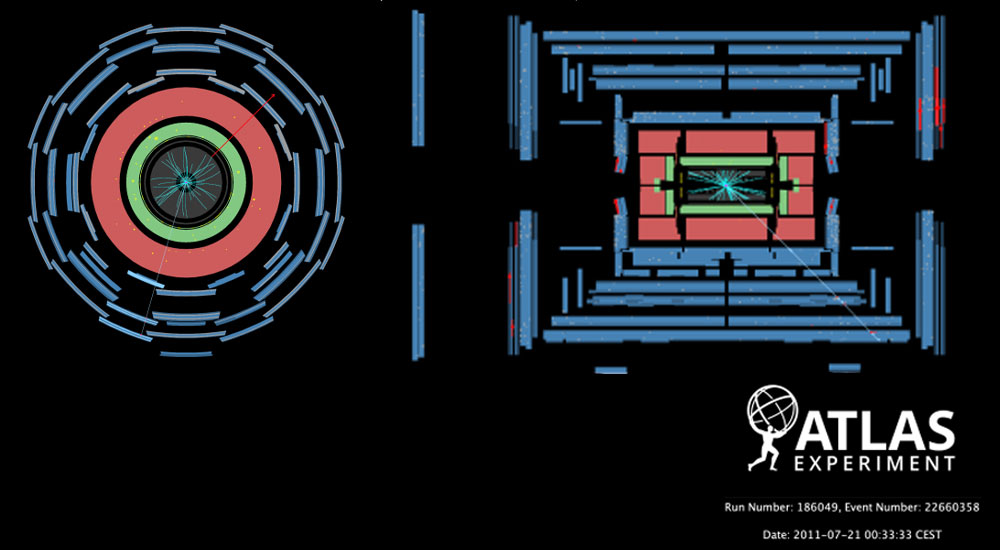Improved ATLAS Result Weighs in on the W Boson
An improved ATLAS measurement of the W boson mass is in line with the Standard Model of particle physics
March 23, 2023
 enlarge
enlarge
Event display of a W-boson candidate decaying into a muon and a muon neutrino inside the ATLAS experiment. The blue line shows the reconstructed track of the muon, and the red arrow denotes the energy of the undetected muon neutrino (Image: CERN)
The following news release about results from the ATLAS experiment at the Large Hadron Collider (LHC) was issued today by CERN, the European particle physics laboratory. The U.S. Department of Energy's Brookhaven National Laboratory serves as the U.S. host laboratory for the ATLAS experiment and plays multiple roles in this international collaboration, from construction and project management to data storage, distribution, and analysis. See more information about Brookhaven's role in research at ATLAS. To interview a Brookhaven Lab scientist about these new results, contact Karen McNulty Walsh, kmcnulty@bnl.gov, 631 344-8350.
Geneva, 23 March 2023. The W boson, a fundamental particle that carries the charged weak force, is the subject of a new precision measurement of its mass by the ATLAS experiment at CERN.
The preliminary result, reported in a new conference note presented today at the Rencontres de Moriond conference, is based on a reanalysis of a sample of 14 million W boson candidates produced in proton–proton collisions at the Large Hadron Collider (LHC), CERN’s flagship particle accelerator.
The new ATLAS measurement concurs with, and is more precise than, all previous W mass measurements except one – the latest measurement from the CDF experiment at the Tevatron, a former accelerator at Fermilab.
Together with its electrically neutral counterpart, the Z boson, the electrically charged W boson mediates the weak force, a fundamental force that is responsible for a form of radioactivity and initiates the nuclear fusion reaction that powers the Sun.
The particle’s discovery at CERN 40 years ago helped to confirm the theory of the electroweak interaction that unifies the electromagnetic and weak forces. This theory is now a cornerstone of the Standard Model of particle physics. CERN researchers who enabled the discovery were awarded the 1984 Nobel Prize in physics.
Since then, experiments at particle colliders at CERN and elsewhere have measured the W boson mass ever more precisely. In the Standard Model, the W boson mass is closely related to the strength of the electroweak interactions and the masses of the heaviest fundamental particles, including the Z boson, the top quark and the Higgs boson. In this theory, the particle is constrained to weigh 80354 million electronvolts (MeV), within an uncertainty of 7 MeV.
Any deviation of the measured mass from the Standard Model prediction would be an indicator of new physics phenomena, such as new particles or interactions. To be sensitive to such deviations, mass measurements need to be extremely precise.
In 2017, ATLAS released its first measurement of the W boson mass, which was determined using a sample of W bosons recorded by ATLAS in 2011, when the LHC was running at a collision energy of 7 TeV. The W boson mass came out at 80370 MeV, with an uncertainty of 19 MeV.
At the time, this result represented the most precise W boson mass value ever obtained by a single experiment, and was in good agreement with the Standard Model prediction and all previous experimental results, including those from experiments at the Large Electron–Positron Collider (LEP), the LHC’s predecessor at CERN.
Last year, the CDF collaboration at Fermilab announced an even more precise measurement, based on an analysis of its full dataset collected at the Tevatron. The result, 80434 MeV with an uncertainty of 9 MeV, differed significantly from the Standard Model prediction and from the other experimental results, calling for more measurements to try to identify the cause of the difference.
In its new study, ATLAS reanalysed its 2011 sample of W bosons, improving the precision of its previous measurement. The new W boson mass, 80360 MeV with an uncertainty of 16 MeV, is 10 MeV lower than the previous ATLAS result and 16% more precise. The result is in agreement with the Standard Model.
To attain this result, ATLAS used an advanced data-fitting technique to determine the mass, as well as more recent, improved versions of what are known as the parton distribution functions of the proton. These functions describe the sharing of the proton’s momentum amongst its constituent quarks and gluons. In addition, ATLAS verified the theoretical description of the W boson production process using dedicated LHC proton–proton runs.
“Due to an undetected neutrino in the particle’s decay, the W mass measurement is among the most challenging precision measurements performed at hadron colliders. It requires extremely accurate calibration of the measured particle energies and momenta, and a careful assessment and excellent control of modelling uncertainties,” says ATLAS spokesperson Andreas Hoecker. “This updated result from ATLAS provides a stringent test, and confirms the consistency of our theoretical understanding of electroweak interactions.”
Further measurements of the W boson mass are expected from ATLAS and CMS and from LHCb, which has also recently weighed the boson.
2023-21157 | INT/EXT | Newsroom









